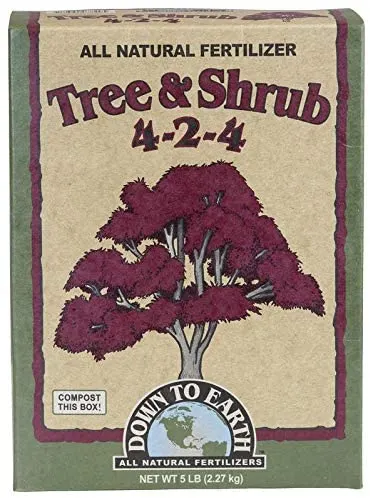Gardeners, farmers, and plant lovers want to see their flowering plants and vegetables growing and healthy. Healthy plants need to be provided with suitable fertilizers containing the perfect combination of ingredients. The solution is going for down to earth fertilizer reviews.
They give the plants fertilizers that are natural, organic, and free of chemicals. There is enough nitrogen, potassium, and phosphorus to promote abundant green foliage, lush new growth, bountiful fruit, and fragrant flowers.
Nitrogen is vital for all growing plants to ensure an abundance of sprouts, flowers, vegetables, and fruits. It is also perfect for heavy feeders such as corn, broccoli, leafy greens, and spinach. These down to earth fertilizer reviews work with microorganisms, organic matter, and fungi in the soil to stimulate growth and nourish plants.
They are blended from the finest organic nutrients in optimal proportions, with no synthetics. Likewise, they are formulated with secondary and primary plant nutrients such as calcium, sulfur, iron, zinc, and selected micronutrients.
- Factors to consider when buying the best down to earth fertilizer reviews
- 5 Best Down To Earth Fertilizer Reviews
- 1. Down to Earth 5-lb All Natural Acid Mix 4-3-6 Fertilizer
- 2. Down to Earth 0-0-22 5-lb Organic Langbeinite Fertilizer
- 3. Down to Earth 4-2-4 5-lb All Natural Shrub & Tree Fertilizer
- 4. Down to Earth 6-3-3 Organic 5-lb Citrus Fertilizer Mix
- 5. Down to Earth 0-11-0 All Natural Seabird 5-lb Guano Fertilizer
- Types of organic fertilizers
- How to fertilize a garden for sowing
- How to fertilize a garden for different crops
- Conclusion
Factors to consider when buying the best down to earth fertilizer reviews
Soil testing
You need to conduct soil testing in your garden before purchasing fertilizers to know the nutrients. This will assist you in determining the correct fertilizer for growing the vegetables. Essentially, you need to know how to test the soil in your garden and how often you should do it.
NPK ratio
Before buying the best down to earth fertilizer reviews, you need to check the NPK ratio. Fertilizers have a different NPK ratio, which shows the formulas in which the elements are blended to make the fertilizer. Typically, these elements are phosphorus, nitrogen, and potassium. Then consider the plant types you need to grow and find the corresponding NPK ratio.
Ingredients
Down-to-earth fertilizer reviews can contain chicken manure, human excrete, chicken feathers, corn gluten meal, and alfalfa, among others, mixed with other nutrients. If you’re concerned about the smell of your fertilizer, do not buy fertilizers that have animal by-products, fish products, or animal or human manure.
Chicken manure and blood meal smell the worst, but they’re the best fertilizers. If you like vegan products, you need to read the label prudently. There are many down to earth fertilizer reviews on the market, though you should consider the ingredients used to make them before you buy them.
Fertilizer form
Down to earth fertilizer reviews are made in different forms, including liquid, granular, and powder forms. You need to decide what form you want before you buy it. Some fertilizers need to be mixed with water before application, while others can be sprinkled directly onto plant leaves.
Application method
When buying the best down to earth fertilizer reviews, you need to consider the application method. You must consider the method which is comfortable for you. These fertilizers can be applied with hand sprayers, rakes, or bare hands.
Budget
You are supposed to check the price of the down to earth fertilizer reviews before you buy to make sure you are using your budget. Although some models can be costly, you can also get cheaper ones.
5 Best Down To Earth Fertilizer Reviews
1. Down to Earth 5-lb All Natural Acid Mix 4-3-6 Fertilizer
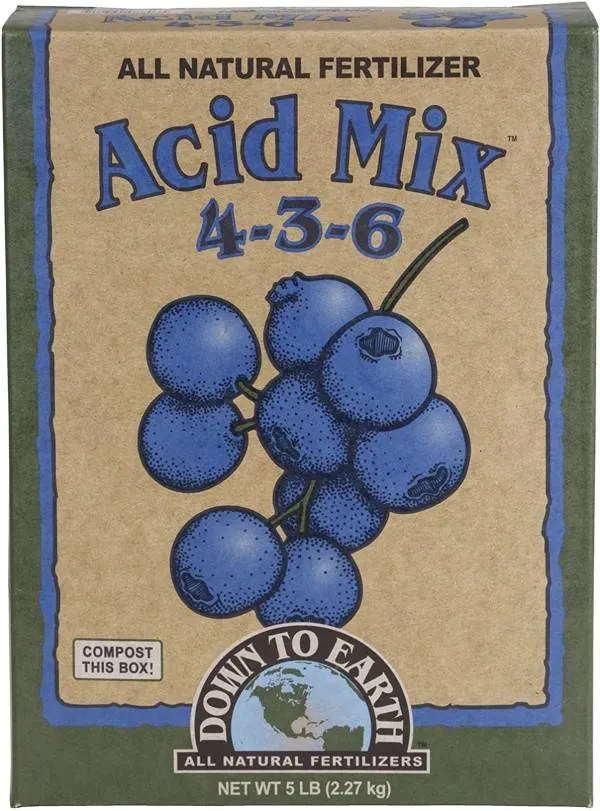
This is one of the best down to earth fertilizer reviews blended particularly for acid lovers like rhododendrons, camellias, azaleas, potatoes hydrangeas, blueberries, evergreens, strawberries, etc., raspberries, and other plants which require low pH. It helps to encourage fruit and lush flowers. You can apply it in early spring for the vegetative growth and then when blooms appear.
Additionally, it has a 4-3-6 formula, which helps to boost resistance to dangerous winter temperatures and promote root growth.
It comes with the unique feature that it can be used by garden centers, nurseries, commercial growers, and home gardeners who need alternatives to conventional chemical products. If you are preparing for new gardens, you can apply 3-6 lbs in every 100 square ft. and carefully mix into a top soil for 3 inches.
Furthermore, you must add 1-2 tablespoon per hole for the new transplants and then mix them into water and soil. In the same case, if you want to feed the established plants, you can carry a side dress of 2 to 4 oz. This depends on the desired growth rate plant size, once every month throughout the growing season.
2. Down to Earth 0-0-22 5-lb Organic Langbeinite Fertilizer
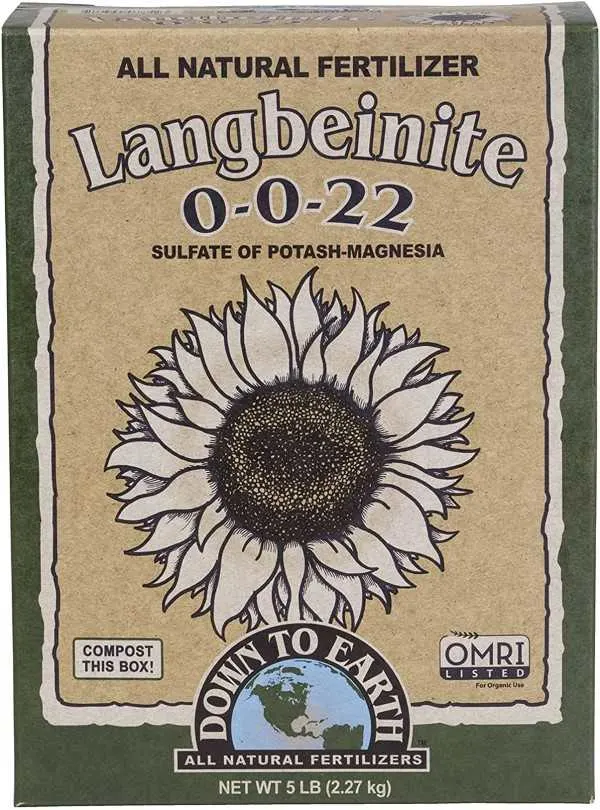
The product is a mined crystalline mineral, which naturally supplies water-soluble sulfate from the three vital plant nutrients: potassium, sulfurs, and magnesium. It is 3-in-1, for it comes with a combination of magnesium, potassium, and sulfur. In the same case, it contains 11% Mg, 22% S, and 22% K2O.
The product is required on fruit crops and sensitive vegetables that need a high fertilization rate but do not withstand a high level of soluble salts or chlorine. Essentially, the maximum chlorine content is less than 3% to minimize the potential for a burn from the fertilizer.
Also, its neutral pH is unique because it doesn’t alter the soil activity. The presence of magnesium is significant because it is needed for chlorophyll synthesis, and sulfur is required for enzyme activation.
I really appreciate the presence of potassium because it contributes strongly to the entire plant’s health by controlling internal processes. Because potassium creates the fluid of a plant, it’s found all over plant tissue, meaning the plants require a strong potassium source as they grow. On the other hand, potassium deficiencies can lead to immature roots and weak stalks, leaving the plant prone to insects.
3. Down to Earth 4-2-4 5-lb All Natural Shrub & Tree Fertilizer
The product is among the down to earth reviews; that is a 5-lb box of all-natural shrub and tree fertilizer with a formula of 4-2-4 and is enriched with mycorrhizal fungi.
Notably, it has a fish bone meal, langbeinite, corn gluten meal, greensand, humates, azomite, mycorrhizal fungi, and kelp meal. In all honesty, it is fortified with eleven species of ecto and endo-mycorrhizal fungi, which help to protect against different plant stresses and encourage wide root development.
Additionally, it is formulated for transplanting container plants, burlap and ball shrubs, and bare root trees. It is best applied by adding to the small holes drilled in the soil or mixing in the soil at planting. Equally important, it helps to ensure survival from drought, transplant shock and other environmental problems, which can negatively impact the growth potential of the young plants.
Commercial growers, home gardeners, and garden and nursery centers who need alternatives to chemical products can use it to promote rapid establishment. In like make manner, it can be mixed directly into soil under bare root trees, cuttings, vines and shrubs or blended into the potting mixes. Essentially, the aim is to ensure physical contact between the inoculated fertilizer and the roots.
4. Down to Earth 6-3-3 Organic 5-lb Citrus Fertilizer Mix
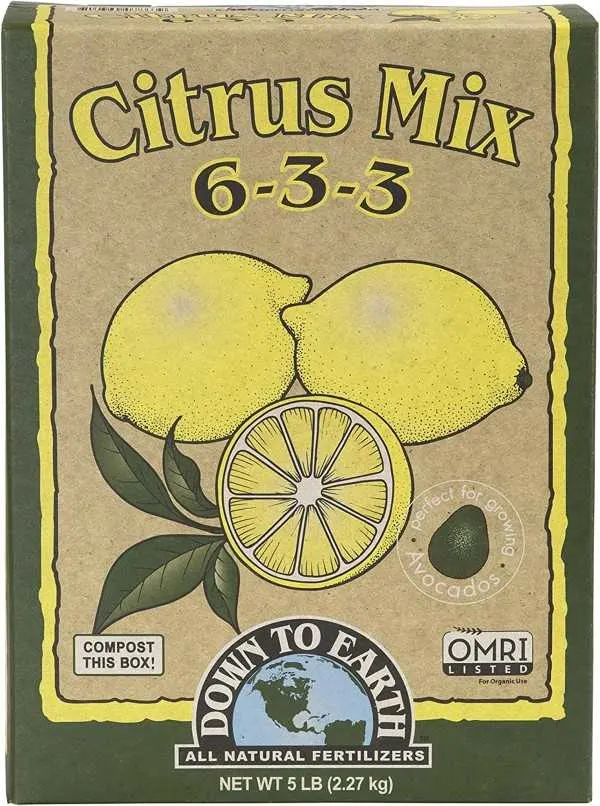
Another down to earth fertilizer reviews is this product, which has a formula of 6-3-3 and is listed by OMRI (Organic Materials Review Institute) for use in organic production.
It is an alternative for citrus trees of every kind and can be used to nourish other vines, ornamentals, and fruit trees for satisfying results. Equally important, it is formulated with secondary and primary plant nutrients like sulfur, calcium, iron, zinc, and selected micronutrients.
This fertilizer supplies the correct ratio of phosphorus, potassium, and nitrogen that helps to promote abundant green foliage, lush new growth, bountiful fruit, and fragrant blossoms. You will get the Ingredients like feather meal, alfalfa meal, fish bone meal, greensand, basalt, langbeinite, sulfate of potash, kelp meal, and zinc sulfate.
After the application, it will give a lovely home garden compliment where you will get vibrant fruits, attractive glossy foliage, and fragrant blossoms. This fertilizer can be applied to mature fruit-bearing trees during the growing season.
For new trees, which is 1-3 years old, you need to prepare the transplant hole and then mix the backfill soil with ½-1 cup. Use the amended soil to cover the new trees and water in the well.
5. Down to Earth 0-11-0 All Natural Seabird 5-lb Guano Fertilizer
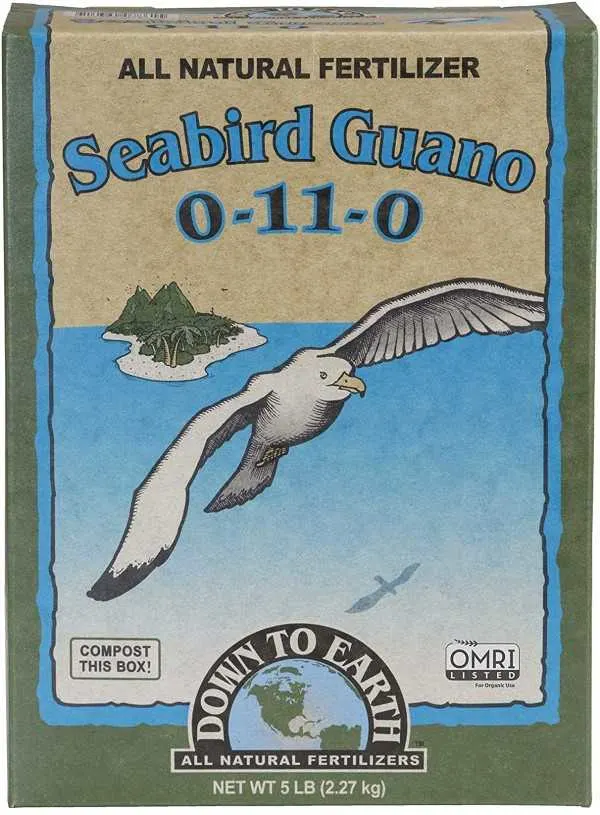
This down to earth fertilizer is a 5-lb box of all the natural fertilizers with a formula of 0-11-0. It can be mixed in the soil or just applied as the liquid to radically increase the size and amount of blooms during the flowering period for all outdoor and indoor plants. Strawberries, vegetables, melons and all flowers types can benefit from it.
During the mid-season application, it improves yields, flavor, and quality to the plants and enhances the beneficial bacteria activities in the garden soil. You will get nutrients like phosphorous that play a significant role in both bloom and root development and help produce high-quality flowers and fruit.
In the same case, phosphorus helps the plants take new soil by improving root development and strong root development. This means the plants will be healthier and grow faster because they will absorb more nutrients and water from the soil. If you want to apply it to the new plantings, you must add 1 to 2 tablespoons to every gallon of soil and then thoroughly mix or add 2.5-5 pounds per cubic yard.
Types of organic fertilizers
a) Peat
The best organic fertilizers include peat, in particular, lowland. In composition, it closely resembles compost as it also consists of dead plants. In lowland peat, approximately half of the mass is carbon. A feature of this organic fertilizer is that the chemical processes of formation occur under a layer of water.
So, the biomass is isolated from the air, and all substances remain in the composition but do not evaporate. Peat is excellent for restoring humus – the top fertile soil layer. The effect of the introduction will be noticeable only after 2-3 years.
b) Manure
Organic nitrogen fertilizers are animal waste. Despite such difficulties, manure is a very popular fertilizer. It is mainly used for horticultural crops. Due to the high nitrogen content, shoot growth and leaf development are accelerated.
Manure belongs to the same class as saltpeter and urea but should not be used together. Otherwise, the balance may be disturbed, which will lead to a loss of yield.
c) Liquid organic fertilizers
Separating liquid fertilizers into a separate class is not entirely correct. The fact is that they are united by the method of application, and the composition and method of preparation can be very different. Liquid, for example, includes modern complex food preparations, which are synthetic.
In widespread natural farming, liquid infusions are called infusions on conventional organic fertilizers. For example, they are made from manure, compost, and bird droppings. There are popular recipes for making dressings from nettles and weeds. Apply organic fertilizers in liquid form after germination. They improve the soil’s condition but are also absorbed by plants through the leaves.
d) Fermentation waste
With the development of alternative energy, a digestor is becoming more and more popular. These are solid wastes that are generated during the synthesis of biogas. They contain nitrogen, phosphorus, and potassium, all necessary minerals for plants.
How to fertilize a garden for sowing
1. Bury in the soil
Spread the down to earth fertilizer reviews on the ground so you can dig up the soil later and leave it buried and mixed. If you use undecomposed fertilizer, do so a few months before planting. 7-10 liters of compost per square meter is sufficient. If it is a strong fertilizer, such as chicken manure, it is recommended to reduce the amount by 1-3 liters per square meter.
2. Sprinkle on the surface
Sprinkle down to earth fertilizer reviews on the soil’s surface, and nature itself (rainwater) will bring nutrients to the roots. This type of fertilizing, also called mulch, is very effective in forests. This is not recommended for sandy soils, nor is the use of bird-derived fertilizers as they change the pH of the ground and acidify the soil.
How to fertilize a garden for different crops
During spring, it is time to grow eggplants, tomatoes, or peppers in summer. These crops need good fertilizer because they consume a lot of nutrients. Let us know how to fertilize a garden for different crops.
a) How to fertilize Citrus Fruits
Citrus fruits require a lot of fertilizer, so you should pay attention to this if you want to grow oranges, tangerines, or grapefruits that require the most fertilizer. To know when to fertilize citrus fruits, it is essential to know that when magnesium is deficient, they need to be re-fertilized.
Therefore, the best time to fertilize citrus fruits is spring and summer. Purchasing a complete citrus fertilizer with an NPK density (18-6-6) will provide the necessary elements and enough citrus to meet the high nutritional requirements of citrus.
b) How to fertilize fruit trees
If you have a small urban garden or grow fruit trees, the most effective fertilizer is vermicompost. There is no doubt that the best time to fertilize fruit trees is in spring and summer. This is when your fruit trees need extra nutrients to keep them growing and producing good fruit. On the other hand, if your fruit trees bear fruit in the fall, adding garden compost may also be a good idea.
Conclusion
Down to earth fertilizer reviews are ideal for the growth and maturity of the plants. You can go for the above product because they have unique features.
For instance, they are enriched with an abundance of mycorrhizal fungi and beneficial bacteria that promote optimal plant rooting, vitality and development. Also, a high level of high-quality ingredients contributes to an eco-friendly and effective approach to plant fertilization, soil care, and plant care.
Down to Earth 0-0-22, 5-lb Organic Langbeinite Fertilizer is the best-selling product because it has magnesium that ensures chlorophyll synthesis. Likewise, it comes with potassium, which contributes strongly to the entire plant’s health by controlling the internal processes.
This product has attained the above factors because magnesium facilitates chlorophyll synthesis and potassium, which contributes strongly to plant health.


